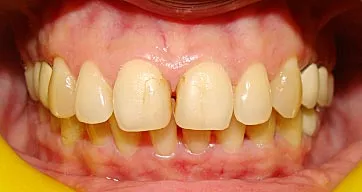Composite Veneers

The two most commonly used materials in the process of veneer fabrication are composite resin and porcelain, and both are popularly used in cosmetic dentistry to transform your smile to be more aesthetically pleasing. Veneers with composite resin are called Composite Laminates and are comparatively cost effective.
It is a quick procedure- typically the same day-treatment, and there is no reshaping of the actual tooth involved. The prepping is minimal and the process is reversible. These Composite Laminates are reconstructions that aim to correct any visual abnormalities of your tooth, such as discolouration and esthetic deficiencies. Composite Laminates are a form of direct laminates and the reconstruction is applied directly on a prepped tooth surface with the composite resin material.
Not only is the procedure minimally invasive, but the finish is very natural and tooth-like, barely detectable to others. The treatment has been developed for advanced esthetic problems pertinent to the front teeth. Composite Laminates can be used to fix erosions and abrasions, coronal fractures, diastemas, rotated teeth, tooth discolouration, discoloured restorations, congenital/acquired malformations like peg lateral incisors, etc.
Case 1
BEFORE

AFTER

Case 2


Call Us
080 55440120
OR
Book an Appointment
Case 3


Case 4


Case 5




” Patient reported with periodontally compromised mobile teeth with poor chewing efficiency. 8 implants in upper and 6 in lower were placed and ceramic bridges were made so that patient could function well with it. “
Composite Laminates – What To Expect ?
Since Composite laminates are typically fabricated in the dentist’s office itself, the process is very short and the entire procedure can be completed in a single appointment. Composite Laminates, also called Composite Bonding, are sculpted directly onto the surface of the tooth.
First, the surface of the tooth is roughened for the composite material to hold on. For direct technique, the Dentist sculpts the entire laminate on to the tooth and for indirect technique, an impression of the tooth is made to create the structure of the initial tooth-shaped resin. This laminate is fabricated by the dentist in his office itself and directly put on the surface of the anterior tooth.
A high-intensity light is used to cure this tooth-shaped resin onto the tooth, making sure there is little porosity. Additional layers of resin are applied on top of this base structure and sculpted by the dentist to bring it to the required shape or aesthetic outcome. The resin is then polished to make the appearance and finish natural and tooth-like.

Composite Laminates
Do composite Laminates ruin your teeth?
Composite resins are used to bind Composite Laminates to the surface of your teeth. This material is completely safe and does not harm or hurt your natural teeth underneath.
How long do Composite Laminates last?
Composite laminates take barely a day to apply, and can last for long depending on the level of maintenance and oral hygiene. These laminates might chip off if it’s not taken proper care of. After some years, they can either be polished up or replaced.
Can you whiten Composite Laminates?
You can’t whiten Composite Laminates like your normal teeth since they don’t respond well to at-home whitening treatments. A visit to the dentist every 6 months can help remove surface stains through professional cleaning. If discoloured you might consider replacing the laminate.
How much do Composite Laminates cost?
Composite Laminates are priced as per the complexity of the procedure. In general, they are about half as expensive as porcelain laminates. The cost is lower than other laminates since it can be fabricated by the dentist itself and requires a single appointment, thus saving a lot of time and laboratory charges.
Is there any specific food that I should avoid while having Composite Laminates?
Since Composite Laminates are not permanently attached to your teeth, they can shift around or get damaged. Some food that you should avoid or be careful with, include meat that requires substantial chewing (such as steak), sticky candy, hard food like hard candy, crunchy food like toast, nuts, seeds, pretzels, etc. are best avoided with laminates.
